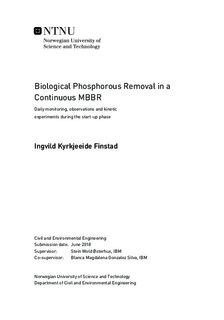| dc.description.abstract | My master thesis is a small part of a larger project called RECOVER. The overall aim of RECOVER is to research the sustainability and reusability of wastewater resources. This master thesis investigates biological removal of phosphorous from wastewater, which is only a small part of the RECOVER researching carbon, phosphorous and nitrogen Recovery in wastewater.
There is an increasing concern for the sustainable delivery of adequate phosphorous resources in the future. Depleting storages of phosphate rock has created a necessity for establishing innovative technology that can help deliver phosphorous in adequate measures. With increasing populations, we need to find sustainable ways to produce phosphorous to meet requirements of food-security. Increasing concentrations of wastewater and industrial water, especially in urban areas, also makes up risks for the sustainability of aquatic habitats and ecosystems. Phosphorous loading into these systems that exceeds their bearing capacity make up a risk for eutrophication and toxicity in these waters. There is already unmistakable evidence of this many places today. Therefore, we need to run our wastewater treatment efficiently and sustainably. Innovative solutions and research into sustainable ways for phosphorous removal will maybe help us solve both beforementioned problems.
Phosphorous can be removed both chemically, physically and biologically. Many WWTP in the world removes phosphorous biologically, and current standard practice for bio-P removal is to use activated sludge processes. Bio-P processes using biofilm with suspended carriers in an MBBR-process is currently not used in full scale, however research on this field is ongoing. There are advantages to the process of Bio-P removal in MBBR some being the reduced need for space and easier handling of sludge. To utilize biological processes for phosphorous removal has many advantages to chemical precipitation like reduced costs for chemicals and an end-product of phosphorous that is not chemically bound.
The Bio-P process in a MBBR does however have some challenges regarding its process as alternating anaerobic and aerobic conditions are required. This necessitates high quality demands for the process design and a better understanding of the operational parameters affecting the process then what we currently have. As the EBPR process is environmentally friendly, sustainable and cost-effective research into possibilities for the implementation of this process in a controlled environment is needed.
The daily monitoring of DO, Temp, pH, was useful tool to observe the changes in the quality of the influent wastewater and use this information to understand process performance better. The main results from evaluation of the daily influent and effluent concentrations of phosphorus, ammonium and sCOD showed signs of the process being affected by dilution in the water. A potential potential shift in the microbial population before and after dilution due to a sudden shift in parameters of substrate feeding, DO, T and pH may have been experienced.
Based on results from kinetic experiments in beaker with wastewater and acetate it was almost zero net consumption of sCOD. Removal rate within the anaerobic chambers were on average is 0.00047 mg sCOD/m2*hr, yet EBPR performance was observed. This is potentially due to a different strain of bacteria inhibiting the biomass than what was previously expected. It was observed that PAOs present in the cMBBR instead potentially ferment other more complex organic molecules.
PAOs survived the low organic loading, thou the anaerobic activity and net uptake decreased. Potentially due to focusing all their energy on survival and growth, outcompeting GAOs. This is positive results regarding initiating this process in the average Norwegian treatment plants as low organic carbon loading is a recurring difficulty to overcome, but it seems PAOs can be competitive.
The biomass has shown the ability to utilize glucose in the anaerobic zone with consequently increased P-removal, however net uptake was not improved when glucose was used at the sole carbon source.
Results from beaker experiments show P release rates in range of 0.6 4.7 mg PO4-P/m2*hr and P uptake rates between 1 and 8.2 mg PO4-P/m2*hr which is significantly lower than comparable literature.
The results also show a strong correlation between temperature and increased rate of release and uptake with a temperature coefficient of 1.077 for anaerobe release of acetate and 1.031 for glucose.
The fact that there is documented P-removal occurring in the pilot shows signs that the biomass has been able to establish itself in a way where it is able to thrive and grow despite conditions being far from what literature states as optimal for EBPR. | |

